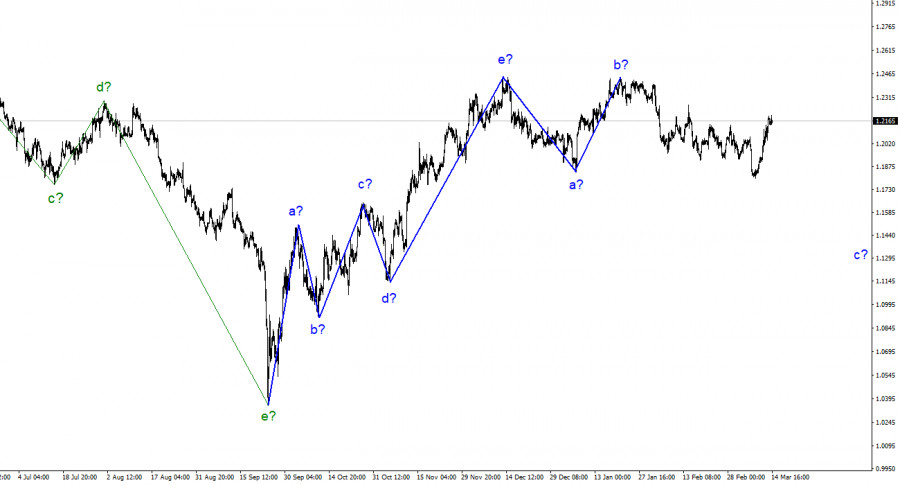

The wave analysis for the pound/dollar pair now appears to be challenging, but it does not call for any clarifications. The wave patterns for the euro and the pound differ somewhat, but both point to a decrease. Our five-wave upward trend section has the pattern a-b-c-d-e and is most likely already finished. I predict that the downward part of the trend has begun and will continue to develop, taking at least a three-wave shape. Although Wave B appeared to be unnecessarily prolonged, it did not cancel. Wave c is also becoming more complex and has an unnecessarily protracted, unfinished appearance. This wave's problem is that it can now end at any time. Wave c can be regarded as finished because the low of wave a has been updated. Of course, I anticipate a more significant drop in the value of the pound, but it should be emphasized that predictions do not always come true. Participants in the market may have been affected by the events at the end of last week. It is now in doubt how wave C will be built with targets so close to the 14th figure. Even inside wave c, isolating the internal waves to determine the stage of development is difficult.
The UK's unemployment rate is constant.
On Tuesday, the pound/dollar exchange rate decreased, increased, and then decreased once more. The pair's amplitude was approximately 35 points, which is fairly low. We've become accustomed to more in recent days. Yet, as I've already mentioned, last Friday and the weekend's news was resonant, ambiguous, and even a little shocking because few people could have predicted the failure of two quite large banks in the United States. As a result, we saw a rather significant movement, which raises doubts about wave C's continued development and the pair's impending demise. The entire downward trend segment has the chance to be finished now that the low of wave c has surpassed the low of wave a. Another concern is whether the British pound has a reason to keep growing.
Data on wages and unemployment have been made public in the UK today. While the market was anticipating a rise to 3.8%, it was revealed that the unemployment rate in January stayed at 3.7%. Moreover, wages and bonuses increased by 6.5%, which was also in line with market forecasts. As a result, there was nothing to react to, and the market did not attempt. But, even if the true value and expectations align, the news on inflation in the United States might trigger stronger market movements. It would be more accurate to say that as of right now, not even the FOMC members can predict what decision will be taken on March 22. This means that the market in particular does not know what to expect.

The development of a downward trend section is implied by the wave pattern of the pound/dollar pair. According to the "down" reversals of the MACD indicator, sales with targets at the 1.1641 level, or 38.2% by Fibonacci, may be taken into account at this time. The peaks of waves e and b could be used to place a Stop Loss order. Wave c might be shorter in duration, but for the time being, I anticipate a minimum 300–400 point decline (from current levels).
The image resembles that of the euro/dollar pair at higher wave scales, but there are still minor differences. The upward correction part of the trend has now been finished. If this presumption is correct, then we should expect the downward part will continue to be built for at least three waves, with the possibility of a decline in the area of 14–15 figures.